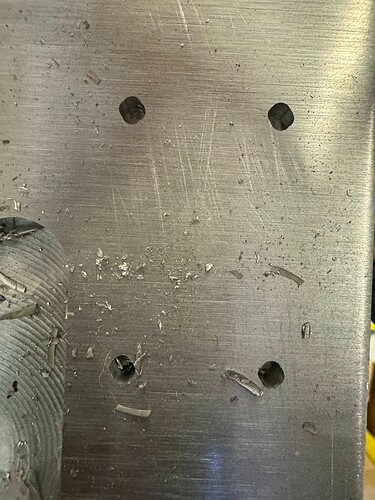Our mill is not able to microstep in curves. We tried replacing the stepper drivers but it did not solve our problem.
Whats your thinking on this? Less vibration? From what I know it doesn’t increase accuracy just resolution. I’m also not sure if the standard Langmuir motor are up for the task.
Maybe one of our CNC gurus can chime in.
The resolution is already very high. I get no faceting on curves. I think your CAM settings might be off. What CAM software are you using and what is your accuracy set at? Here is an example of the surface finish I just got a couple minutes ago. https://youtube.com/shorts/oGtk7HN_Yxw?feature=share Micro-stepping is not going to make it any better than this.
Also you can’t just go from 200 steps per rev to 2000 steps per rev without scaling the data going to the drive. Other wise you’ll just move 10x less distance. The steps on cut control need to match the drive. If the controller says go 200 steps and you change the drive to 2000 steps per rev you will not get a full revolution.
Also the more you increase the micro stepping the more you reduces your holding torque.
I’m also curious what you’re running into that’s concerning you in curves.
If it’s something you’re seeing on your machined part I’d post up a picture and maybe a snippet of the g code for your tool finishing that surface. It’ll be easier to diagnose with a visual reference and the commands given to the machine.
I had the same exact issue. I make tiny parts, and the smaller they got the less accurate they were. If it’s capable of nailing a 1.5" width over 6" with no deviation, it should be able to a 0.050" width accurately. I’m using fusion 360, and when you post process there are several tolerance settings for minimum arc and cord, some were set quite large. I decreased them to less than 0.001" and my results are WAY better. The machine is absolutely capable, if you’re feeding it the right info.
You can see this in the simulation feature of Fusion 360 if you zoom in. The curves turn into facets until you dial in your tolerance parameters.
@microarms I’d love to see your workholding tricks. I was working on a small part yesterday that got too small for my insert-vise and was brainstorming on ways to hold it. In the past I’ve used glue/tape (works well for one off parts that are very flat) or small holding hardware like Mitee-bites (requires making a one-off fixture). I sort of wish I had a half-size insert vise with 1/2" wide jaws, but I did a quick search and didn’t find any for sale.
I seemed to have a situation where as the path was adjusted to fit within the tolerances, it expanded the path and actually made the entire part larger by about 0.007". Reducing the tolerances actually made the part closer to nominal. I didn’t even imagine that would be a thing.
I wish I had some genius miniature fixturing to show you, but I don’t. I mostly just machine what details I can from the stock piece (generally 1/16" flat bar), then cut the perimeter and let the part fly. lol. Haven’t actually lost that many, but I’m tired of having to do manual cleanup on the parts. I have lots of things I’m experimenting with, powder coat tape and super glue, screwing parts down to fixtures with 0-90 screws, I have mitee-bite uniforce clamps that look very promising, I even have some wax type stuff for lapidary work that you melt and it’s supposed to hold better than glue. But alas, I am struggling to find time with keeping product available, developing new things, and some legit r&d.
Here is some more information:
-We are using fusion 360 to CAM the parts
-We are concerned because when we mill out holes (boring 3/16’’ holes with a 1/8’’ flat endmill), the holes are not circular (see image)
-We cannot do small curved movements, when drilling holes it would be circular but would go diagonal and make noncircular holes
-It can only move in striaght lines when microstepping, it cannot microstep in curves
-Even in the air, it does this
-It can do larger parts
-For boring, the tolerance setting was .0004’’
My MR1 mill bores perfect cicle all the way down to a 1/8 and probably smaller if I tried.
I would be looking for other problems or problem.
I’ve definitely done smaller bores without issue. Check your backlash and travel compensation on the machine. It would have to be pretty bad to cause that. You might try a gcode visualizer to see if your path indeed looks like that. That actually helped me figure out my issues with my tiny parts.
I’d definitely like a peak at the G code for those holes. That almost looks like the arc is going concave instead of convex. Definitely odd behavior.
